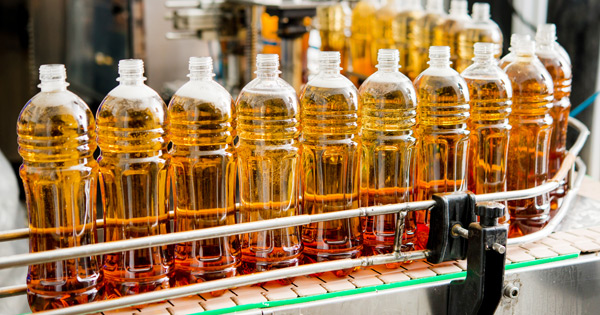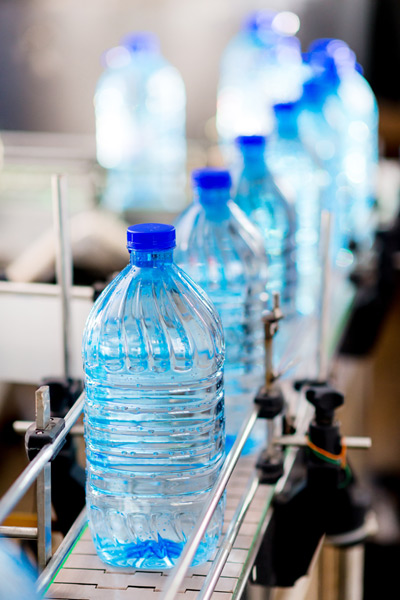Criteria for selecting the right type of liquid filling equipment for consumer-sized containers are considered here, with a focus on in-line filling systems. (Counter pressure fillers used for carbonated beverage will be covered in future articles.)
How To Buy Liquid Filling Equipment To Produce Your Consumer Product
Before selecting liquid filling equipment, there are a few things that you need to know about your speeds, product and packaging.

Start By Defining Your Liquid Filling Production Requirements
Before you embark on purchasing liquid filling equipment, make sure you can answer the following questions:
How many bottles do you need to produce in a given day, month, and year? – Most liquid fillers can have multiple nozzles filling a number of bottles each cycle. By defining the number of bottles you need to fill, you’ll know more about what type of liquid filling equipment to buy, based on production volume.
Do you want to fill containers semi automatically or automatically? – That process typically includes: Indexing the bottles on a conveyor, filling, capping, labeling, coding, accumulation etc. automatically.
Do you want to turn on and off each machine in the process or do you want the system to communicate internally so it runs as efficiently as possible? – One of the defining specifications for the filling system will be the level and sophistication of the machinery controls that you need or want.

Know the Properties of Your Product
To select the right filling system, you’ll need to know and define the product itself, and also the specifics of the container. The product specifications that need to be defined include:
- Viscosity,
- Particulate size
- Hot fill or cold fill
- pH,
- Response in viscosity to shear
- Level of foam with shear
Know the Specifications of Your Packaging
The following packaging specifications will impact what type of liquid filling system you should buy. Make sure you define the following information regarding your packaging:
- Fill size
- Fill temperature
- Container material
- Container dimensions
- Container shape
- Neck opening
- Cap type
- Cap style
The properties of your product and container will not only determine the type of liquid filling machine you should buy overall, but the various options you may want to consider. Options that may or may not be needed include:
- Bottom up filling
- Neck grabbers
- Drip trays
- Return lines
Now that you know these important product and container criteria, you can begin to evaluate the type of filling system that is best suited for your requirements.
Types of Filling Equipment Machines
Timed Fillers
Timed filers work by metering liquid through a pump for a finite time. The result is a consistent fill if a few criteria are met. The liquid needs to be a low viscosity. Typically product that’s more viscous that salad oil will not perform on timed fillers. Product should also not have particulates. With timed fillers, the product typically is metered through the pump and through a manifold to multiple filling nozzles. The product flows for a given time and each of the nozzles delivers product to the receiving container. These fillers do not typically have shut-off nozzles so the manifold will have flow controls so an equal amount flows through each nozzle during the timed cycle. These fillers are ideal for small operations and where the fill levels are less than 8 ounces. Timed fillers require product consistency in the temperature and viscosity. A variation of either will impact fill levels.
Piston Fillers
Piston fillers fall under the group called positive displacement fillers. This is probably the most popular style of filler for small and medium-sized consumer product filling applications. With a piston filler, the product is drawn into a chamber as the piston is drawn back. The product is then pushed out and into the receiving container when the piston pushed forward. The product is drawn into the piston chamber from a hopper above the piston or pulled from a tank or kettle. The diameter and stroke of the piston will determine how much volume the piston filler delivers each cycle. Piston fillers will have a number of options that allow them to handle products that’s water thin up to thick pastes. They are consistent as long as the product flows through the piston assembly and they can handle hot and cold products. A temperature controlled hopper can keep the product at a consistent temperature. Pistons fillers can consist of a single piston or grouped up to 12 or more.
Gear Pump Fillers
Gear pump fillers also fall under the group called positive displacement fillers. Gear pumps have small cavities that are rotated, filled, and forced out the container. The number of rotations will determine the volume of the fill level. Products from light liquids through to heavy creams and pastes can be run through gear pump fillers. Each nozzle has its own independent volumetric pump giving the high accuracy. Fill speed typically is faster than a piston but both are accurate. The speed advantage also comes with a higher price tag than piston fillers as each nozzle requires a pump and motor. Product can be fed either from a hopper above or from a drum below. In multi-station fillers, the bottles index via a conveyor under the entire bank of pistons where they are filled. Then the containers are released and the next batch of containers come in.
Peristaltic Pumps
Peristaltic is a type of displacement pump. It is used for fairly slow volumes where precise metering is required and typically when the product is very expensive, corrosive, or when the risk of cross contamination is critical. Often used in medical or chemical applications, the pump parts never actually never touch the product. Peristaltic pumps work by compressing and relaxing a hose that’s positioned between a rotating device and a circular pump housing. The rotation draws fluid into the hose, and then pushes it out through the replaceable tube forcing the product to the container.
Diaphragm Pump
An air-operated diaphragm pump pulls product into a cavity and through one-way valves. The diaphragm also pushes the liquid out another set of one-way valves when it flexes in the opposite direction. These are not used for precise applications but more likely for filling drum or buckets and also as a feeder pump to a filler hopper.
Pressure Over-Flow Fillers
Pressure over-flow fillers fill the container to a set level through a nozzle. Once that level is reached, a drilled hole allows excess product to flow backward to the hopper. These fillers often are used when the brand owner wants the bottles to look as if the fill height in the bottles is exactly the same as the consumer looks at them as they sit on a retail shelf. The reality is that when bottles are made, the volume inside them is not exactly the same. If the bottles are filled with the exact same volume they can appear they filled to different levels. The Overflow filler accommodates that by filling to a fill level rather than putting the same amount in each container.
Gravity Fillers and Pressure Gravity Fillers
Gravity filling is a very simple filling method. The supply tank has filling tubes with nozzles attached to the bottom of the bowl at each container filling point. A vent tube extends upward into the filler bowl to a point above the liquid level. When the valves open, they allow the product to fill the containers and excess product to flows back through the vent tube. These are simple and affordable but do not work well with products that foam excessively. It also works better with thin viscosity products. Heavy products can be assisted by light vacuum or positive pressure, but heavy pastes also fall outside the scope of this style of filler.
For more information and advice about what type of liquid filling equipment that’s right for your product, your container, your production goals, and your business, contact us at: 303.347.4704, or Email Us.
